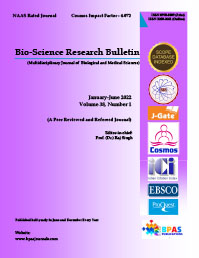Nutritional Approach for the Treatment of Anemia and Iron Deficiency Anemia
DOI:
https://doi.org/10.48165/Keywords:
Anemia, Iron deficiency anemia, Dietary Iron, Absorption, NutritionAbstract
Around the globe every year around ten million lives are lost due to hunger and undernutrition. Multitudes of people are impinged on by “hidden hunger,” a lack of essential vitamins and minerals, which is known as micronutrient deficiencies. Worldwide till date iron deficiency remains as the top ranking source of anemia. The consequences of poor nutrition are not always prominent to notice. Infants, young children and women of child- bearing age are those at greatest risk of nutritional anemia besides the men. Over 30% of the world’s population – are anemic with about 1 billion suffering from iron deficiency anemia (Gleason G.). The etiology of ID and IDA is complex and has a prolonged imbalance between dietary intake, absorption and body needs which in the long run leads to iron deficiency anemia. However this article focuses on the nutritional approach for the balance of iron absorption in the body thereby reducing the occurrence of ID and IDA.
References
Adamson J.W. (2008) Iron deficiency and other hypoprolifirative anemias. In B. E. Fauci A.S., Harrison's Principles of Internal Medicines). New York: Mc-Graw Hill Medicals, 628-634 2. Banjari I., K. D. (2013). Iron bioavailability in daily meals of pregnant women. Journal of Food and Nutrition Research, 52; 203-209.
Banajari I. (2012). Dietary intake and iron status and incidences of anemia in pregnancy [thesis]. Zagreb: University of Zagreb
Banjari I. (2018) Iron deficiency anemia in pregnancy. Retrieved from Intech: http://dx.doi.org/10.5772/ intechopen.69114
Besarab A, H. S. (2018). Iron deficiency Anemia. Springer Science+Business Media LLC 2018 Management of Anemia , 15.
Black M.M., Q. A. (2011;69). Iron deficiency and iron deficiency anemia in the first two years of life:Strategies to prevent loss of developmental potential. Nutrition Review, S64-S70. 7. Boulpaep E.L., B. W. (2006). Medical physiology. Philadelphia: Elsevier, Saunders ISBN 978-1-4160- 3115-4.
Clara Cameschella, M. (2015). Review Article Iron deffeciency Anemia. The New England Journal of Medicine, 1832.
Clark S.F. (2008). Iron deficiency anemia. Nutr Clin Prac, 23(2), 28-41.
Cornah J.E., R. J. (2002). Measurement of ferrochelatase activity udsing a novel assay suggests that plastids are the major site of haem biosynthesis in both photosynthetic and non photosynthetic cells of pea(Pisum sativum L). Biochem J., 362(Pt 2); 423-432.
Diaz M., R. J. (2003). The efficacy of a local ascorbic acid rich food in improveming iron absorption from mexican food:A field study using stable isotopes. Am Jclin Nutr, 78(3); 436-40. 12. Gleason .G., S. N. (2007). An overview of the fiunctyional significance of iron deficiency. In Z. M. Kraemer K., Nutritional Anemia (pp. 38-42). Switerland: Sight and Life press.
Gracia O.P., D. M. (2003). Ascorbic acid from lime juice do not improve the iron status iron - deficient women in rural mexico. Am J Clin Nutr, 78(2); 267-73.
Hallberg L., H. L. (2000;71). Prediction of dietary iron absorption:An algorithm for calculating absorption and bioavailability of dietary iron. The American Journal of Clinical Nutrition, 1147-1160. 15. Hentze M.W., M. (2010). Two to tango:regulation of mammalian iron metabolism. Cell, 14; 24-38. 16. Hurrell R.F., R. M. (1999). Inhibition of non-haeme iron absorption in man by polyphenolic containing beverages. British Journal of Nutrition, 81(4); 289-295.
Kristensen M.B., T. I. (2005). A decrease in iron status in young healthy women after longterm daily consumption of the recommended intake of fibre-rich wheat bread. European Journal of Nutrition , 44(6); 334-340.
Lynch S.R. (1997). Interaction of iron with other nutrients. Nutrition Reviews, 55(4); 102-110. 19. Lynch S.R. (2000). The effect of calcium on iron absorption. Nutritional Research Review, 13; 141- 158.
Means RT., J. m. (2004). Hepcidin regulates iron efflux by binding to ferroportin and inducing its internalization. Science , 306; 2090-93.
Nemeth E.Tuttle MS, P. J. (2004). Hepcidin regulates cellular iron efflux by binding to ferroportin and inducing its internalization. Science; 306(5704) doi:10.1126/science. 1104742, 2090-2093. 22. Reddy M.B., H. R. (2007x). Meat consumption in a varied diet marginally influences nonheme iron absorption in normal individuals. Journal of Nutrition, 306; 576-581.
Robert T. Means, J. (2019). Treatment of Iron Deficiency Anemia in adults. In J. Robert T. Means, Nutritional Anemia: Scientific Principles, Clinical Practise and Public Health. Britain: Cambridge University Press, 85-92
T. Ganz. (2011). Hepcidin and iron regulation,10 years later. The American Society of Hematology, 4425-33.
Thompson B. (2007). Food based approaches for combating iron deficiency. In Z. M. Kraemer K., Nutritional Anemia (pp. 337-358). Sight and Life Press.
Vulpe, G. J. (2010). Iron Deficiency and Overload. New York: Humana Press, c/o Springer Science Business Media, LLC, 233 Spring Street.
